Knowledge
Training for Busy People: A Blessing In Disguise?
Training

Those of us who’ve been training hard and eating well for years will have undoubtedly had what seems like endless conversations with friends/family/colleagues that end with something like:
“Oh yeh, I’d love to go to the gym regularly, but I just don’t have time.”
Or
“I’d love to be strong and muscular, but I have a busy job/family/pet rock I need to care for.”
Usually, this is a simple case of “you make time for what’s important,” and these people, for all their talk, aren’t willing to make an effort and commitment. These people will often claim they’re very busy but spend 4 hours per day on Facebook and watching Sex and the City re-runs.
On the flip side, people out there genuinely do not have the time to train often.
Enter: The (Genuinely Busy Person)
The bad news:
These people will often have demanding jobs (50-60 hours+/week), a young family, and any further commitments on top. It’s simply not realistic to expect that individual to do the same training plan as someone with low stress 9-5 job and no other commitments. Firstly, they don’t have enough free time to do it. Secondly, even if they could, it would probably be counter-productive as their baseline cortisol will be much higher (more on this later).
So what’s the good news??
Not having a lot of time to train means you need to focus on two things:
Efficiency
Quality over Quantity
The most common pitfall in most people’s training is too much volume. They make up for lack of effort and intensity by doing far too many sets, and they make up for lack of knowledge in exercise selection by doing every exercise under the sun. This leads to excessive cortisol, meaning they make fewer gains.
Well, as a busy person, you simply don’t have the time to fall into this trap! You have no choice but to focus on efficient workouts that get the job done quickly. As a result, you may end up progressing MORE than your less busy counterparts.
The Cortisol Issue
As mentioned previously, people with many commitments are going to have a higher baseline cortisol level. It’s stressful juggling all these things!
Volume is the most significant factor controlling cortisol release in your training, followed by intensiveness (how difficult each set is). So a productive training plan will need to:
- Do minimal workload possible to achieve the required stimulus.
- Take advantage of training styles that don’t cause excessive cortisol.
- Use more intense loading schemes sparingly.
So how do we do that? Luckily for you, I’ve written a 9-week hypertrophy plan that does exactly those three things.
The Busy Person Training Plan
This 9-week plan is set out into 3 x 3-week blocks. The intensity increases as the blocks progress, but it shouldn’t feel like a big step up at a slow enough rate. The plan is based on three workouts per week: 1 upper body, one lower body, and one whole-body session. This allows you to stimulate all your muscle groups twice per week while not being too difficult to recover from.
The vast majority of the work is formatted into super-sets. Super-sets will increase cortisol release slightly (as you’re essentially multi-tasking), BUT the benefit of the amount of time you save by training in this matter far outweighs this small drawback.
I’ve provided you with several options for each exercise in the training plan. These options have been chosen as they best align with the training method applied to them. There isn’t a right or wrong choice here; simply go with the one feels best for you (doesn’t make you feel beat up, etc.) and/or that you feel in the target muscle the most.
Let’s talk about some things you need to know and the training methods that are involved.
How To Read Lifting Tempo
You’re right; this isn’t particularly fun or exciting. But when it comes to the training techniques being used here, this is the thing that people f*** up most regularly. So pay attention. If an exercise has the following tempo prescription, it means this:
4021
First Digit – length of eccentric phase (target muscle is being lengthened), in this case, 4s
Second Digit – length of pause at the end of the eccentric phase (i.e., when the bar is on your chest in a bench press), here there is no pause in that position (0s)
Third digit – length of concentric phase (target muscle is shortening), here it is 2s, which is pretty much normal lifting tempo
The fourth digit – pause at the end of concentric phase (i.e., when hands are together at the end of cable fly), which here is 1s. In many isolation movements, this is the point when you can “squeeze” the target muscle maximally.
Right, the math lesson is over, so that you can get rid of that glazed-over expression now.
Hypertrophy Methods
The workouts in this program will focus on one or two different hypertrophy methods within training. You must have a basic understanding of these other methods so that you know how you’ll be expected to perform the exercises.
Method 1 – Lactate Accumulation
This method focuses on accumulating as much lactate in the target muscle within a set as possible. This method only works when the target muscle is kept under constant tension for the whole set. The constant tension has an occlusion effect in the muscle, making it difficult for blood to remove the lactate. This method’s benefit is that it causes little/no muscle damage, so it’s very easy to recover from. It’s not all easygoing, though; this method stings worse than standing on a LEGO brick (if you don’t know how that feels, consider yourself lucky).
Important takeaway: During lactate, work make sure the target muscle is never allowed to relax and focus on squeezing it as hard as possible at all times
Method 2 – mTOR
mTOR is an enzyme present in muscle cells that is very important for the muscle growth process. Activating mTOR leads to a cascade of reactions that causes a heightened protein synthesis rate in the muscle. mTOR is best activated by using a slow eccentric and stretching the muscle while under load. mTOR style work does involve some muscle damage but is still reasonably easy to recover from
Important takeaway: Best used with exercises that place the target muscle in a stretched position (i.e., chest fly). Exaggerate the eccentric by actively flexing the target muscle as it lengthens through the movement. Hold the stretch position for 2-3s on each rep, still flexing the muscle as hard as possible.
Method 3 – Muscle Damage
Yes, you guessed it, this method does involve considerably more muscle damage than the previous two methods. Therefore it takes the highest toll on your recovery ability, which is why it is used sparingly in this plan. The hypertrophy stimulus here is literal damage (on a micro-scale) to the muscle fibers, which signals the body to repair and rebuild thicker fibers.
Important takeaway: For muscle damage, you need to stick to pretty heavy loads. If you can lift it for more than ten reps, it’s probably too light for this approach.
Method 4 – Strength-Skill
Strength-skill refers to lifting reasonably heavy loads (80-90% 1RM) in a sub-maximal manner (i.e., doing sets of 2 with a weight you could lift 5/6 times). This helps build strength through technique reinforcement and can be an excellent way to build volume under a heavy load without causing too much stress. I’ve included some strength-skill work in the final block for two reasons. A, it’s always good to do at least some strength work, and B, this would make it easier to transition to a more strength-focused program after this one (should you wish to)
Important take-way: Strength-skill work doesn’t work if you lift like shi**. The idea is to reinforce perfect form. Likewise, if you’re using a weight you feel nervous about and have to psych yourself up for, then it’s too heavy.
The Training Plan
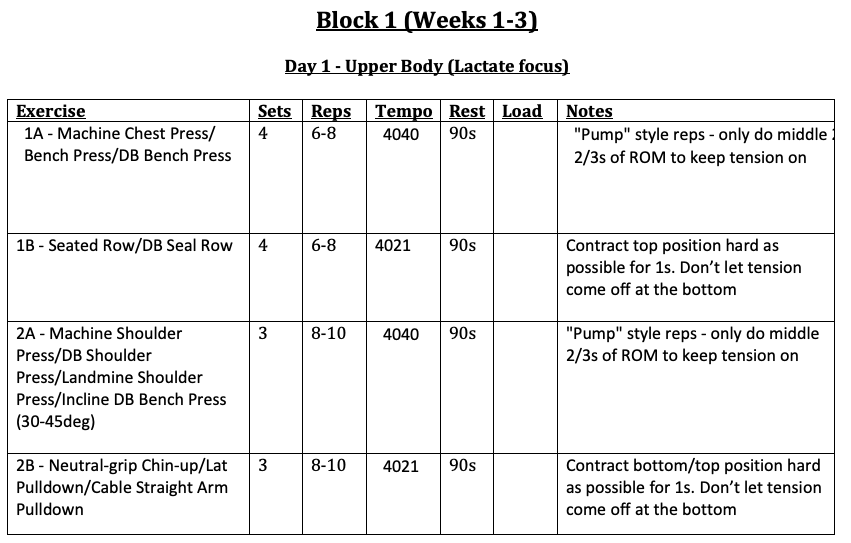
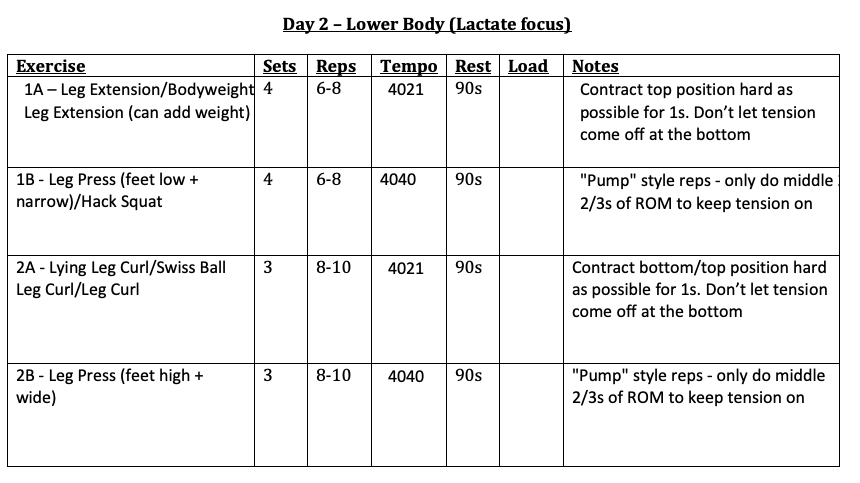
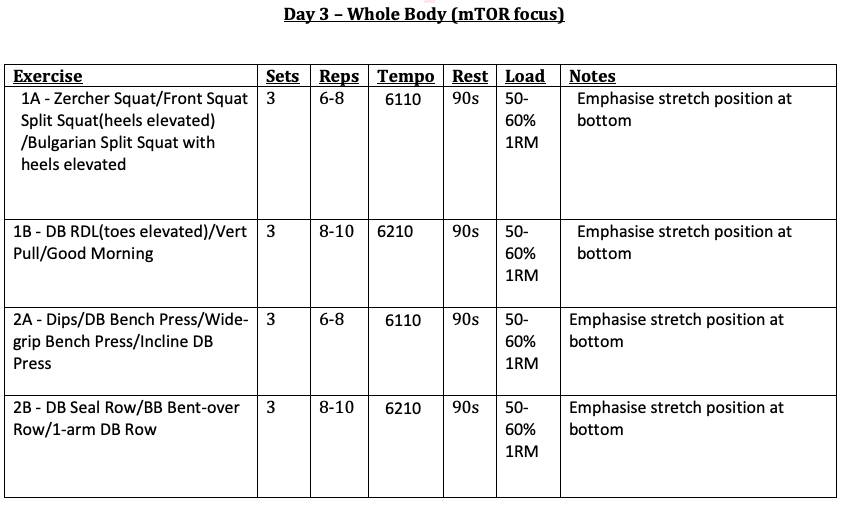
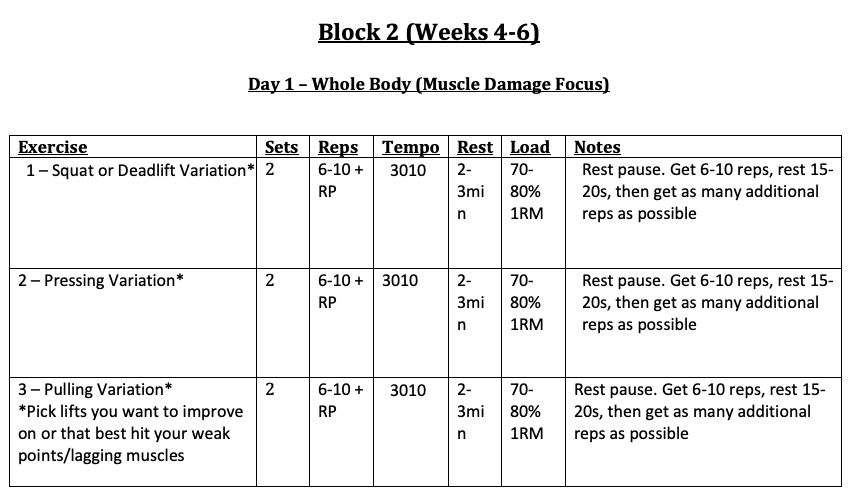
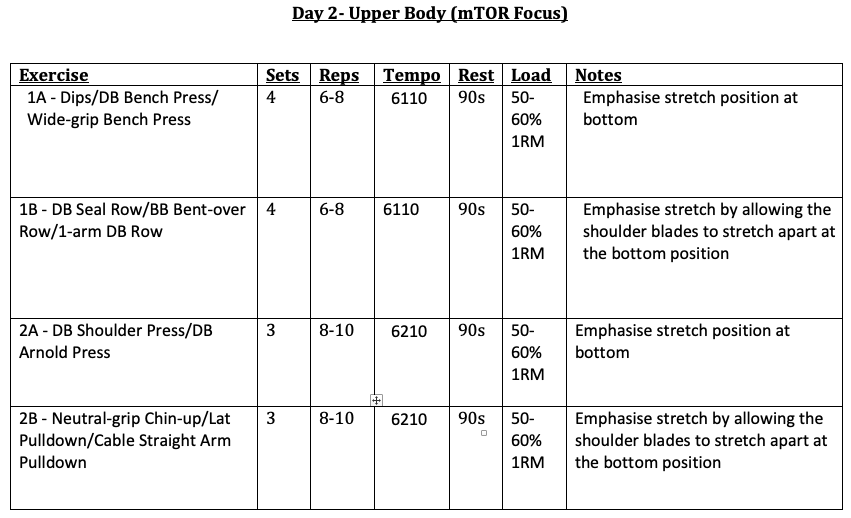
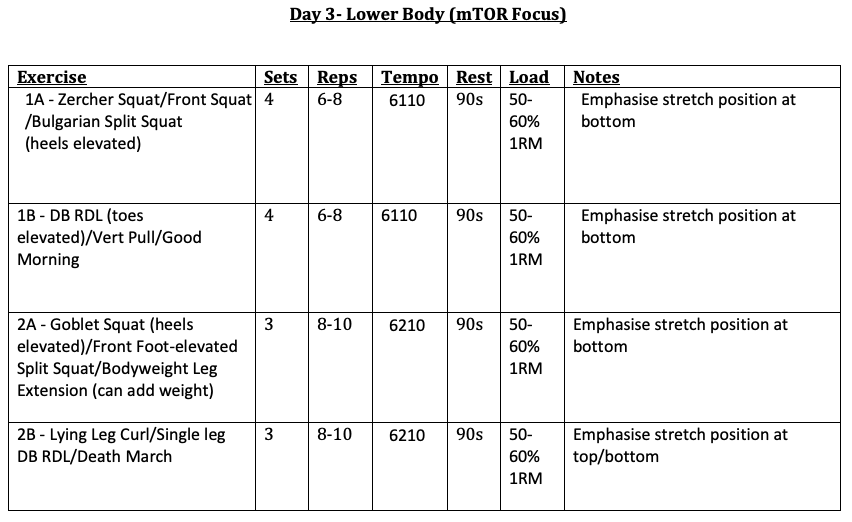
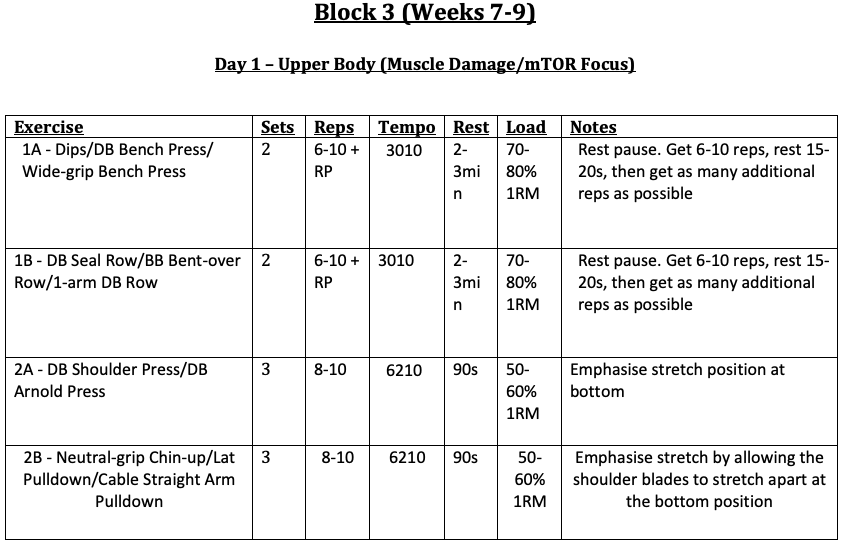
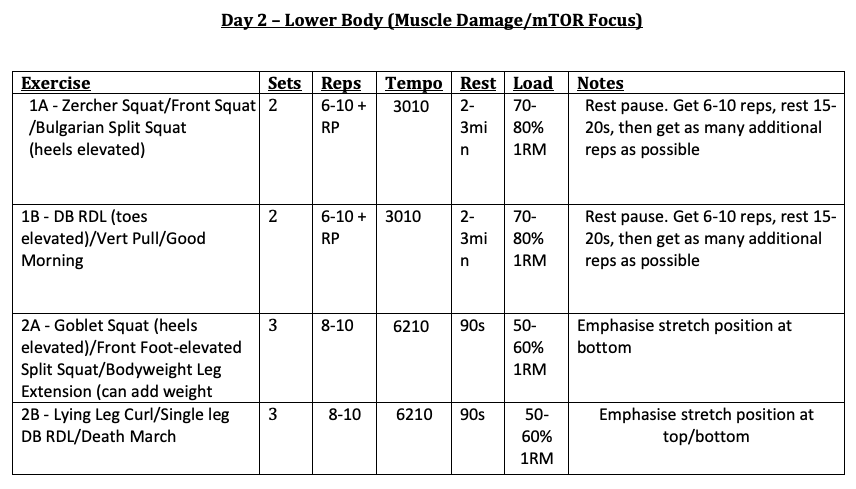
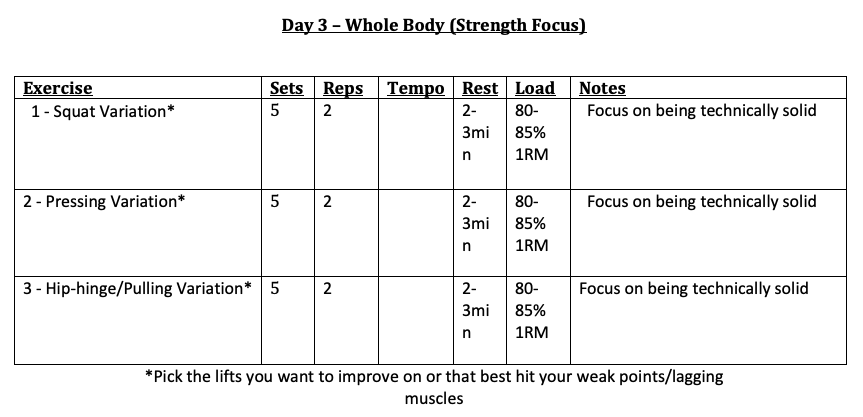
Can I do any extra work?
If you can make time for more than the prescribed workouts each week then you can add in a small amount of non-stressful work.
If your goal is pure hypertrophy you can add some resistance band work on some of your off days. Shoot for 100 total reps on 4-6 different isolation movements, ideally ones that target your weaker muscle groups. Options include:
- Leg Extension
- Leg Curl
- Band Pull-apart
- Straight-arm Pulldown
- Bicep Curl
- Tricep Pressdown
- Lateral Raise
- Front Raise
If your focus is more on body composition you could simply add in some low-intensity cardio on some of your off days. As a general rule of thumb, I’d keep cardio to 20-30 minutes at a time at a heart rate of 110-120bpm to avoid any excess cortisol. Pick whatever method of cardio makes you feel the least suicidal.
Conclusion
Being busy doesn’t mean you don’t have time to make gains, it just means you need to be smart about it. Plus it means you don’t have the time to fall into the common pitfall of doing garbage volume. If you’re willing to work hard, using the right methods, you can make way more gains than all the gym-bros spending 3 hours training chest and biceps every evening.
– Thomas Sheppard